The phosphorothioic trichloride market, valued at USD 58.5 million in 2025, is set to reach USD 99.9 million by 2035, with a CAGR of 5.5%. From 2021 to 2025, the market experiences gradual growth, moving from USD 44.7 million in 2021 to USD 58.5 million in 2025.
Annual increments in this phase reflect steady demand, with the market reaching USD 47.2 million in 2022, USD 49.8 million in 2023, USD 52.5 million in 2024, and USD 55.4 million in 2025. This early phase of growth is driven by the increasing use of phosphorothioic trichloride in agrochemicals, particularly in crop protection, and in pharmaceuticals. The market remains stable as its applications continue to expand within the chemical synthesis sector.
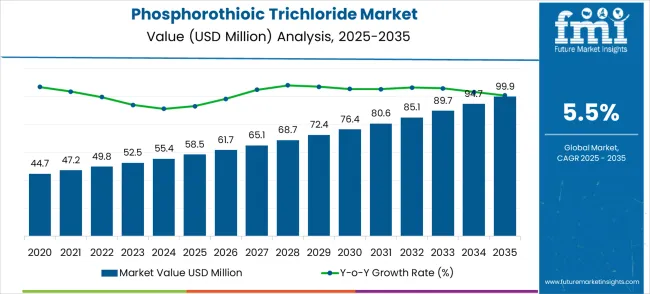
The second phase, starting around 2026, marks a significant acceleration in market growth, moving from USD 58.5 million in 2025 to USD 76.4 million in 2030. This period witnesses increased adoption in specialized chemical applications, especially in manufacturing pesticides, herbicides, and other agricultural chemicals.
The inflection point occurs as industries recognize the enhanced performance offered by phosphorothioic trichloride in chemical processing. By 2035, the market is expected to reach USD 99.9 million, with values passing through USD 89.7 million and USD 94.7 million in intermediate years. The steady growth during this phase reflects broadening industrial applications and increasing demand, driven by both global agricultural needs and new chemical innovations.
The chemical manufacturing market is the largest contributor, accounting for around 40-45%, as phosphorothioic trichloride is used in the production of pesticides, flame retardants, and other specialty chemicals. The agrochemical market follows with a contribution of approximately 20-25%, as phosphorothioic trichloride is an important intermediate in the synthesis of organophosphate insecticides and herbicides, which are crucial in crop protection and pest control.
The pharmaceutical market represents about 10-12%, as phosphorothioic trichloride is used in the production of certain drugs, including those with anti-inflammatory and antimicrobial properties. The plastics and polymers market contributes around 8-10%, as the compound is used in the manufacture of various flame retardants that are incorporated into plastics for enhanced safety in electrical and electronic applications.
The water treatment market accounts for approximately 5-7%, as phosphorothioic trichloride is employed in water purification processes to remove heavy metals and other contaminants.
| Metric | Value |
|---|---|
| Estimated Value in (2025E) | USD 58.5 million |
| Forecast Value in (2035F) | USD 100 million |
| Forecast CAGR (2025 to 2035) | 5.5% |
Market expansion is being supported by the increasing demand for specialized chemical intermediates in pesticide manufacturing and the corresponding need for high-purity phosphorothioic trichloride in pharmaceutical synthesis applications. Modern agricultural practices require effective crop protection chemicals that depend on sophisticated intermediates like phosphorothioic trichloride for their production. The compound's unique chemical properties and reactivity make it an essential reagent for various organophosphorus synthesis processes used in agrochemical and pharmaceutical formulations.
The growing emphasis on pharmaceutical research and specialty chemical manufacturing is driving demand for phosphorothioic trichloride derived from reliable production processes with consistent quality standards. Industrial preference for high-purity chemical intermediates that provide enhanced reaction efficiency and product yield is creating opportunities for specialized formulations. The rising influence of regulatory compliance requirements and quality assurance standards is contributing to increased adoption of premium phosphorothioic trichloride across different industrial applications and manufacturing processes.
The market is segmented by purity, application, and region. By purity, the market is divided into 98% purity and >98% purity. By application, the market is categorized into organic synthesis, pesticide intermediates, and matrix fine chemicals. Regionally, the market is divided into North America, Europe, East Asia, South Asia & Pacific, Latin America, and Middle East & Africa.
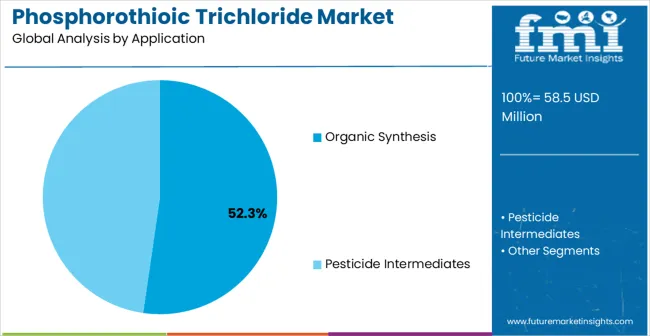
The organic synthesis application is projected to account for 52.3% of the phosphorothioic trichloride market in 2025, reaffirming its position as the category's primary use case. Chemical manufacturers increasingly understand the importance of phosphorothioic trichloride in creating complex organophosphorus compounds used in various industrial applications. The compound's well-documented reactivity and selectivity directly address synthesis requirements by enabling precise chemical transformations, supporting reaction efficiency, and maintaining product quality standards.
This application forms the foundation of most industrial positioning, as it represents the most versatile and chemistry-validated use of phosphorothioic trichloride in manufacturing. Research institutions and chemical companies continue to strengthen reliance on phosphorothioic trichloride formulations. With industrial processes requiring more sophisticated chemical intermediates, organic synthesis aligns with both efficiency and innovation goals. Its broad applicability across chemical sectors ensures steady dominance, making it the central growth driver of phosphorothioic trichloride demand.
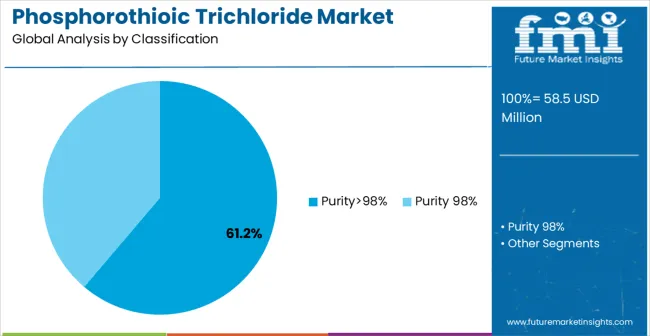
High-purity phosphorothioic trichloride (>98% purity) is projected to represent 61.2% of market demand in 2025, underscoring its role as the preferred grade for critical chemical applications. Industrial users gravitate toward high-purity grades for their enhanced reaction performance, reduced impurity interference, and ability to meet stringent quality specifications required in pharmaceutical and specialty chemical manufacturing. Positioned as premium, specialized reagents, high-purity grades offer both superior chemical performance and regulatory compliance benefits.
The segment is supported by the rising demand for quality-controlled manufacturing processes, where high-purity phosphorothioic trichloride plays a central role in production strategies. Companies are increasingly combining high-purity phosphorothioic trichloride with advanced handling protocols and quality assurance systems, enhancing reliability and justifying premium pricing. As quality-conscious manufacturers prioritize performance and compliance, high-purity phosphorothioic trichloride will continue to dominate demand, reinforcing its premium positioning within the specialty chemicals market.
The phosphorothioic trichloride market is advancing steadily due to increasing demand for specialty chemical intermediates and growing applications in pharmaceutical synthesis processes. The market faces challenges including regulatory compliance requirements, handling safety protocols, and competition from alternative chemical reagents. Innovation in manufacturing technologies and green production practices continue to influence product development and market expansion patterns.
The growing adoption of advanced pharmaceutical synthesis is enabling companies to develop more sophisticated drug compounds and specialty chemical products. Pharmaceutical applications offer enhanced reaction capabilities, specialized chemical transformations, and advanced manufacturing processes that influence development decisions. Research and development investments are driving innovation and product advancement, particularly among pharmaceutical companies who prioritize chemical intermediate quality and regulatory compliance in manufacturing operations.
Modern phosphorothioic trichloride manufacturers are incorporating advanced production systems such as continuous processing, automated quality control, and real-time monitoring to enhance product consistency and manufacturing efficiency. These technologies improve the reliability of phosphorothioic trichloride while reducing production costs and providing better quality assurance. Advanced manufacturing techniques enable specialized products that deliver enhanced chemical performance and regulatory compliance in industrial applications.
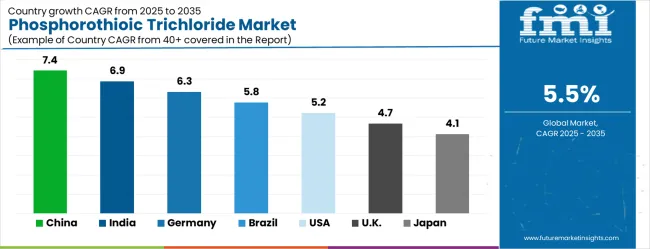
| Country | CAGR (2025 to 2035) |
|---|---|
| China | 7.4% |
| India | 6.9% |
| Germany | 6.3% |
| Brazil | 5.8% |
| USA | 5.2% |
| UK | 4.7% |
| Japan | 4.1% |
The phosphorothioic trichloride market is experiencing solid growth globally, with China leading at a 7.4% CAGR through 2035, driven by extensive pesticide manufacturing, expanding pharmaceutical industry, and growing chemical synthesis activities. India follows at 6.9%, supported by agricultural modernization, increasing crop protection needs, and expanding pharmaceutical manufacturing capabilities.
Germany records 6.3%, focusing on high-purity applications and advanced chemical manufacturing standards. Brazil shows 5.8% growth, driven by agricultural chemical demand and expanding industrial chemistry sector. The USA demonstrates 5.2% growth, emphasizing regulatory compliance and specialty applications. The UK and Japan show steady growth at 4.7% and 4.1% respectively, focusing on high-value applications and technological innovation.
The report covers an in-depth analysis of 40+ countries with top-performing countries highlighted below.
The phosphorothioic trichloride market in China is projected to exhibit the highest growth rate with a CAGR of 7.4%, driven by extensive pesticide manufacturing activities and expanding pharmaceutical intermediate production. The country’s large agricultural base, which requires advanced crop protection products, is fueling demand for chemical intermediates.
China’s rising pharmaceutical output and diversified chemical sector further boost consumption of phosphorothioic trichloride. Major domestic players are enhancing large-scale production facilities to supply both domestic and export markets, reflecting the country’s dominant role in the global chemical value chain.
Strategic collaborations, technology transfer programs, and supportive government policies toward agricultural modernization are enabling China to expand its foothold in premium chemical intermediates. Increasing adoption of high-purity grades in pharmaceuticals and industrial chemicals is strengthening growth prospects, making China the largest contributor to global market expansion.
Revenue from phosphorothioic trichloride in India is expanding at a CAGR of 6.9%, supported by rising agricultural chemical demand and the growth of pharmaceutical manufacturing. India’s reliance on agriculture and its focus on improving crop productivity are pushing higher adoption of effective pesticide intermediates.
With government-backed initiatives promoting agricultural modernization, farmers are increasingly adopting crop protection solutions, creating a strong base for phosphorothioic trichloride usage. The growing pharmaceutical sector, particularly generic drug manufacturing, demands high-quality chemical intermediates meeting global regulatory standards. Indian manufacturers are developing production capacities to serve the fast-expanding domestic market while exploring exports to neighboring countries.
Cost competitiveness, availability of skilled workforce, and ongoing investments in chemical manufacturing infrastructure position India as one of the fastest-growing markets globally. This combination of agriculture-led demand and pharmaceutical expansion is driving substantial opportunities for market players.
Demand for phosphorothioic trichloride in Germany is projected to grow at a CAGR of 6.3%, underpinned by the country’s advanced chemical sector and its emphasis on specialty chemicals. Germany has a reputation for producing premium-grade chemical intermediates, and manufacturers are investing in purification technologies to deliver high-purity phosphorothioic trichloride for pharmaceutical and specialty applications.
The market is characterized by a focus on environmental responsibility, regulatory compliance, and technical innovation. German firms are leveraging R&D to enhance product quality and efficiency, aligning with strict EU chemical regulations.
This strong focus on precision and technical excellence ensures that German manufacturers remain competitive in high-value applications such as pharmaceuticals, specialty chemicals, and research sectors. With increasing emphasis on environmentally responsible production, Germany is also setting standards for green chemical intermediate manufacturing.
The phosphorothioic trichloride in Brazil is expanding at a CAGR of 5.8%, supported by its vast agricultural base and increasing demand for crop protection chemicals. As one of the largest global exporters of agricultural products, Brazil’s reliance on effective pest management solutions directly fuels demand for phosphorothioic trichloride.
Local chemical manufacturers are expanding production capacity to support domestic pesticide companies and ensure reliable supply chains. Brazil’s agricultural modernization, coupled with rising adoption of advanced crop protection practices, continues to strengthen demand for pesticide intermediates.
Government initiatives to enhance industrial production capabilities and attract foreign investment in chemicals are also aiding market development. By balancing agricultural requirements with domestic chemical manufacturing growth, Brazil is ensuring steady market expansion. Competitive pricing strategies and local supply advantages position Brazilian producers strongly in both domestic and regional markets.
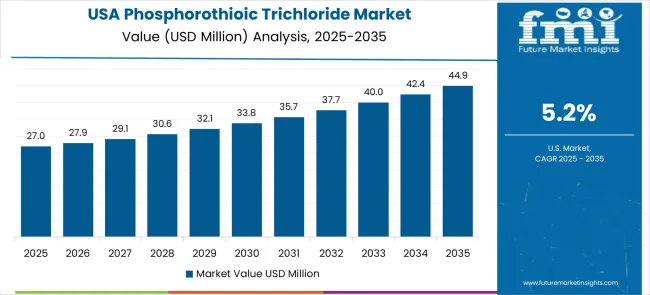
The USA market for phosphorothioic trichloride is expected to expand at a CAGR of 5.2%, shaped by stringent environmental and safety regulations alongside strong demand for high-purity chemical intermediates. American manufacturers are focusing on compliance with EPA and FDA requirements while catering to specialized needs in pharmaceuticals and advanced chemical research. The USA benefits from a robust pharmaceutical industry, which increasingly requires ultra-pure intermediates for drug synthesis.
The advanced R&D capabilities allow for innovative applications in specialty chemicals and biopharmaceuticals. The country’s established quality assurance systems, coupled with technological leadership, provide a competitive edge in producing premium-grade phosphorothioic trichloride. Growing emphasis on eco-responsibility, safety, and precision in chemical manufacturing aligns with broader regulatory and market trends, ensuring long-term stability for USA producers.
Revenue from phosphorothioic trichloride in the UK is anticipated to grow at a CAGR of 4.7%, driven by the country’s specialty chemical manufacturing sector and research-oriented applications. The UK is focusing on niche, high-value applications in pharmaceuticals and advanced chemical synthesis.
Manufacturers are emphasizing innovation, regulatory compliance, and eco-conscious practices to remain competitive in premium segments. With significant investments in R&D and collaborations with research institutes, the UK market is increasingly oriented toward producing high-purity intermediates for specialized uses.
The emphasis on quality and customization supports pharmaceutical companies and research laboratories requiring precision chemical intermediates. Growing export opportunities also contribute to market growth, with UK producers targeting international markets for specialty-grade products.
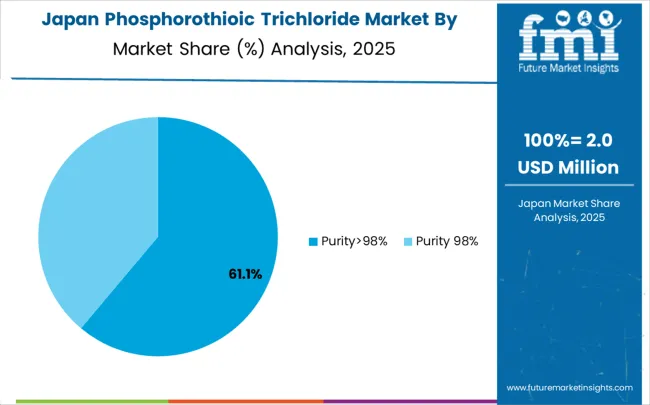
Demand for phosphorothioic trichloride in Japan is forecasted to grow at a CAGR of 4.1%, underpinned by advanced chemical manufacturing capabilities and technical excellence. Japan’s manufacturers emphasize ultra-high purity standards, catering to demanding applications in pharmaceuticals, specialty chemicals, and electronic intermediates.
Strong research and development collaborations between industry and academia support innovation and ensure consistent product quality. Japan’s established regulatory framework and long-standing focus on precision manufacturing give it a leadership role in producing premium-grade phosphorothioic trichloride.
Technological sophistication, combined with expertise in eco-friendly and efficient production methods, provides a strong competitive advantage. Although the growth rate is relatively moderate, Japan’s focus on high-value, specialized applications ensures strong profitability and market stability.
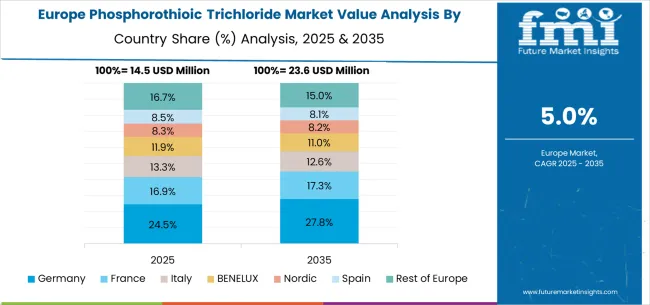
The phosphorothioic trichloride market in Europe demonstrates mature development across major chemical manufacturing regions with Germany showing strong presence through its scientific approach to specialty chemical production and industrial appreciation for high-quality intermediate compounds, supported by companies leveraging chemical engineering expertise to develop effective phosphorothioic trichloride formulations that serve pharmaceutical synthesis and agrochemical manufacturing applications with enhanced purity and performance characteristics.
France represents a significant market driven by its chemical industry heritage and sophisticated understanding of organophosphorus chemistry, with companies like Rhodia and Arkema pioneering specialty phosphorothioic trichloride products that combine French chemical innovation with advanced manufacturing systems for enhanced product quality and industrial application benefits. The UK exhibits considerable growth through its embrace of pharmaceutical manufacturing and chemical intermediate production, with companies focusing on high-purity phosphorothioic trichloride formulations and comprehensive quality assurance systems.
Italy and Spain show expanding interest in agrochemical applications, particularly in premium phosphorothioic trichloride formulations targeting pesticide intermediate production and specialty chemical manufacturing. BENELUX countries contribute through their focus on chemical industry innovation and green manufacturing practices, while Eastern Europe and Nordic regions display growing potential driven by increasing chemical manufacturing capabilities and expanding access to specialty chemical intermediates across diverse industrial applications.
The phosphorothioic trichloride market is characterized by competition among established chemical manufacturers, specialty chemical companies, and emerging industrial players. Companies are investing in advanced manufacturing technologies, quality control systems, regulatory compliance protocols, and supply chain optimization to deliver effective, reliable, and accessible specialty chemical solutions. Product positioning, manufacturing innovation, and market expansion are central to strengthening product portfolios and market presence.
Lanxess, Germany-based, leads the market with 12.3% global value share, offering high-quality phosphorothioic trichloride formulations with a focus on manufacturing excellence and industrial applications. BHAGWATI CHEMICALS, India, provides cost-effective, high-concentration phosphorothioic trichloride products with transparent quality documentation and competitive pricing. Anhui Jinquan Biotechnology, China, delivers science-backed formulations with emphasis on product purity and industrial education. Xinyi Yijin Chemical, China, focuses on reliable, effective formulations that combine phosphorothioic trichloride with complementary quality assurance systems.
Jiangsu Kuaida Agrochemical and Zhejiang Jiahua Energy Chemical, operating regionally, provide comprehensive phosphorothioic trichloride product ranges across multiple industrial sectors and distribution channels. Regional suppliers emphasize specialized applications and manufacturing reliability with premium positioning. Industrial distributors offer quality-controlled products with regulatory compliance and comprehensive documentation. Specialty chemical manufacturers provide specialized solutions with focus on specific industrial requirements and customer preferences.
Phosphorothioic trichloride (PSCl₃) represents a specialized segment within the fine chemicals industry, serving as a critical intermediate in organophosphorus synthesis, particularly for pesticide manufacturing and advanced chemical processing. With a market valued at USD 58.5 million and growing at 5.5% annually, this niche chemical faces unique challenges around regulatory compliance, specialized handling requirements, and concentrated production capabilities. The market's growth depends on coordinated efforts across regulatory bodies, specialized chemical manufacturers, safety technology providers, and targeted investment in process innovation.
| Items | Values |
|---|---|
| Quantitative Units (2025) | USD 58.5 million |
| Purity | 98% purity, >98% purity |
| Application | Organic synthesis, Pesticide intermediates, Matrix fine chemicals |
| Regions Covered | North America, Europe, East Asia, South Asia & Pacific, Latin America, Middle East & Africa |
| Countries Covered | United States, Germany, China, India, United Kingdom, Japan, Brazil, France, Italy, Spain and 40+ countries |
| Key Companies Profiled | Lanxess, BHAGWATI CHEMICALS, Anhui Jinquan Biotechnology, Xinyi Yijin Chemical, Jiangsu Kuaida Agrochemical, Zhejiang Jiahua Energy Chemical, Hubei Xianlin Chemical, Shandong Mingxin Chemical, Gujarat Organics Limited, and Nantong Yongsheng Chemical |
| Additional Attributes | Dollar sales by purity level and application type, regional demand trends across North America, Europe, and Asia-Pacific, competitive landscape with established manufacturers and emerging suppliers, buyer preferences for quality versus cost considerations, integration with regulatory compliance and safety protocols, innovations in manufacturing processes, purification technologies |
North America
Europe
East Asia
South Asia & Pacific
Latin America
Middle East & Africa
The global phosphorothioic trichloride market is estimated to be valued at USD 58.5 million in 2025.
The market size for the phosphorothioic trichloride market is projected to reach USD 99.9 million by 2035.
The phosphorothioic trichloride market is expected to grow at a 5.5% CAGR between 2025 and 2035.
The key product types in phosphorothioic trichloride market are purity>98% and purity 98%.
In terms of application, organic synthesis segment to command 52.3% share in the phosphorothioic trichloride market in 2025.






Our Research Products

The "Full Research Suite" delivers actionable market intel, deep dives on markets or technologies, so clients act faster, cut risk, and unlock growth.

The Leaderboard benchmarks and ranks top vendors, classifying them as Established Leaders, Leading Challengers, or Disruptors & Challengers.

Locates where complements amplify value and substitutes erode it, forecasting net impact by horizon

We deliver granular, decision-grade intel: market sizing, 5-year forecasts, pricing, adoption, usage, revenue, and operational KPIs—plus competitor tracking, regulation, and value chains—across 60 countries broadly.

Spot the shifts before they hit your P&L. We track inflection points, adoption curves, pricing moves, and ecosystem plays to show where demand is heading, why it is changing, and what to do next across high-growth markets and disruptive tech

Real-time reads of user behavior. We track shifting priorities, perceptions of today’s and next-gen services, and provider experience, then pace how fast tech moves from trial to adoption, blending buyer, consumer, and channel inputs with social signals (#WhySwitch, #UX).

Partner with our analyst team to build a custom report designed around your business priorities. From analysing market trends to assessing competitors or crafting bespoke datasets, we tailor insights to your needs.
Supplier Intelligence
Discovery & Profiling
Capacity & Footprint
Performance & Risk
Compliance & Governance
Commercial Readiness
Who Supplies Whom
Scorecards & Shortlists
Playbooks & Docs
Category Intelligence
Definition & Scope
Demand & Use Cases
Cost Drivers
Market Structure
Supply Chain Map
Trade & Policy
Operating Norms
Deliverables
Buyer Intelligence
Account Basics
Spend & Scope
Procurement Model
Vendor Requirements
Terms & Policies
Entry Strategy
Pain Points & Triggers
Outputs
Pricing Analysis
Benchmarks
Trends
Should-Cost
Indexation
Landed Cost
Commercial Terms
Deliverables
Brand Analysis
Positioning & Value Prop
Share & Presence
Customer Evidence
Go-to-Market
Digital & Reputation
Compliance & Trust
KPIs & Gaps
Outputs
Full Research Suite comprises of:
Market outlook & trends analysis
Interviews & case studies
Strategic recommendations
Vendor profiles & capabilities analysis
5-year forecasts
8 regions and 60+ country-level data splits
Market segment data splits
12 months of continuous data updates
DELIVERED AS:
PDF EXCEL ONLINE

Thank you!
You will receive an email from our Business Development Manager. Please be sure to check your SPAM/JUNK folder too.
Chat With
MaRIA